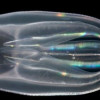В 1930-е гг. профилактику полиомиелит делали за счет мягкого отправления обонятельного эпителия раствором сульфата цинка. Т.к. убивали обонятельные рецепторы нах и лишали человека обоняния на несколько месяцев (потом обонят рецепторы регенирирует, но хуже во взрослом возрасте).
Вообще соли тяжелых металлов Zn Ni Co Cd Hg и т.к. при даже вдыхании пыли быстро всасываются обонятельными рецепторами, а у крыс и мышей потом находят высокие концентрации например Zn в обонятельных луковицах и вообще в мозге. Механизм не ясен, но вроде активный транспорт кажется с участием специфического для обонятельной системы белка-карнозина (carnosine). Так что широко используемый еще с 1970х гг. способ аносмии (блокировании обоняния) у голубей и других птиц промыванием носовой полости растворами ZnSO4 вполне могу вызывать повышенную концентрация ионов Zn в некоторых областях мозга и вообще менять нейрофизиологию мозга (н-р firing rate и прочее)
По сути эффект промывания носовой полости раствором сульфата цинка и проверка эффекта этого воздействия на навигацию птиц (ольфакторную к примеру) на самом деле может быть реализован через общую, вероятно несильную, но всё же эффективную интоксикацию мозга, что в свою очередь может влиять на много какие когнитивные функции организма. По сути нужно начинать с токсикологических исследований - как повышается концентрация цинка в разных областях мозга подобного treatment.
https://www.ncbi.nlm.nih.gov/pmc/articles/PMC536677/pdf/canmedaj00195-0034.pdf
Что почитать:
http://www.annclinlabsci.org/content/31/1/3.short
Nasal Toxicity, Carcinogenicity, and Olfactory Uptake of Metals
+Author Affiliations
Department of Chemistry and Biochemistry, Middlebury College, Middlebury, Vermont, and Department of Pathology, College of Medicine, University of Vermont, Burlington, Vermont
- Address correspondence to F. William Sunderman Jr., M.D., 270 Barnes Road, Whiting, VT 05778-4411, USA; tel 802 462 2507; fax 802 462 2673, e-mail 103040.3027@compuserve.com.
- Received 2 October 2000.
- Accepted 16 November 2000.
Abstract
Occupational exposures to inhalation of certain metal dusts or aerosols can cause loss of olfactory acuity, atrophy of the nasal mucosa, mucosal ulcers, perforated nasal septum, or sinonasal cancer. Anosmia and hyposmia have been observed in workers exposed to Ni- or Cd-containing dusts in alkaline battery factories, nickel refineries, and cadmium industries. Ulcers of the nasal mucosa and perforated nasal septum have been reported in workers exposed to Cr(VI) in chromate production and chrome plating, or to As(III) in arsenic smelters. Atrophy of the olfactory epithelium has been observed in rodents following inhalation of NiSO4 or αNi3S2. Cancers of the nose and nasal sinuses have been reported in workers exposed to Ni compounds in nickel refining, cutlery factories, and alkaline battery manufacture, or to Cr(VI) in chromate production and chrome plating. In animals, several metals (eg, Al, Cd, Co, Hg, Mn, Ni, Zn) have been shown to pass via olfactory receptor neurons from the nasal lumen through the cribriform plate to the olfactory bulb. Some metals (eg, Mn, Ni, Zn) can cross synapses in the olfactory bulb and migrate via secondary olfactory neurons to distant nuclei of the brain. After nasal instillation of a metal-containing solution, transport of the metal via olfactory axons can occur rapidly, within hours or a few days (eg, Mn), or slowly over days or weeks (eg, Ni). The olfactory bulb tends to accumulate certain metals (eg, Al, Bi, Cu, Mn, Zn) with greater avidity than other regions of the brain. The molecular mechanisms responsible for metal translocation in olfactory neurons and deposition in the olfactory bulb are unclear, but complexation by metal-binding molecules such as carnosine (β-alanyl-L-histidine) may be involved.



Комментарии (0)